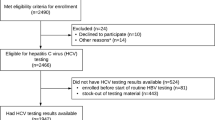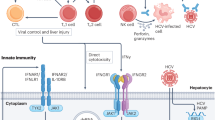Abstract
Risk factors affecting vertical hepatitis C virus (HCV) transmission are not completely known, if we exclude maternal HIV coinfection. We hypothesized that immunogenetic factors related to maternal or neonatal HLA profiles may affect HCV vertical transmission. HLA typing (microcytotoxicity assay on blood samples) was performed in 18 infants affected by vertically transmitted HCV infection and in 17 serum-reverted infants. (Serum-reversion is defined as antibody negative by 1 year of age and persistently HCV-RNA negative.) Moreover, HLA typing was performed in 20 mothers. Logistic regression analysis showed a significant negative association between children's HLA-DR13 antigens and risk of HCV vertical transmission (p < 0.01). This association persisted in a model including the maternal HIV status: HLA DR13 and maternal HIV coinfection showed a separate, opposite effect on vertical HCV infection (p < 0.01 and p < 0.001, respectively). The relative risk estimate for the ratio of not-infected to infected children in the presence of DR13 was 8.4 (95% confidence bounds, 1.1–60.8). Breast-feeding did not affect the risk of vertical HCV transmission. Maternal HLA profile did not relate to vertical infection. The present study reveals a significant association between HLA-DR13 and the likelihood of seroreversion in infants born to HCV-infected mothers. The findings of the present study could help in better understanding the pathogenesis of vertical HCV infection and in better identifying the cases at higher risk, which would be useful for the development of prevention strategies. It is possible that DR13 modulates the immune response to viruses, enhancing their clearance and, thus, in the case of HCV, exerting a protective role against the development of vertical infection.
Similar content being viewed by others
Log in or create a free account to read this content
Gain free access to this article, as well as selected content from this journal and more on nature.com
or
Abbreviations
- HCV:
-
hepatitis C virus
- RT-PCR:
-
reverse transcriptase-PCR
References
Tovo PA, Palomba E, Ferraris G, Principi N, Ruga E, Dallacasa P, Maccabruni A 1997 Increased risk of maternal-infant hepatitis C virus transmission for women co-infected with human immunodeficiency virus type 1. Clin Infect Dis 25: 1121–1124
Zanetti AR, Tanzi E, Newell ML 1999 Mother-to-infant transmission of hepatitis C virus. J Hepatol 31: 96–100
Diepolder HM, Gerlach JT, Zachoval R, Hoffmann RM, Jung MC, Wierenga EA, Scholz S, Santantonio T, Houghton M, Sauthwood S, Sette A, Pape GR 1997 Immunodominant CD4+ T-cell epitope within non-structural protein 3 in acute hepatitis C virus infection. J Virol 71: 6011–6019
Ibe M, Sakaguchi T, Tanaka K, Saito S, Yokota S, Tanaka T, Shimotohno K, Chujoh Y, Shiratori Y, Omata M, Miwa K, Takigucki M 1998 Identification characterization of a cytotoxic T-cell epitope of hepatitis C virus presented by HLA-B*3501 in acute hepatitis. J Gen Virol 79: 1735–1744
Resti M, Azzari C, Mannelli F, Moriondo M, Novembre E, De Martino M, Vierucci A . Tuscany Study Group on Hepatitis C Virus Infection in Children 1998 Mother to child transmission of hepatitis C virus: prospective study of risk factors timing of infection in children born to women seronegative for HIV-1. BMJ 317: 437–441
Terasaki PI, Bernoco D, Park MS, Ozturk G, Iwaki Y 1978 Microdroplet testing for HLA-A, -B, -C, -D antigens. The Phillip Levine Award Lecture. Am J Clin Pathol 69: 103–120
Lin HH, Kao JK, Hsu HY, Ni YH, Chang MH, Huang SC, Hwang LH, Chen PJ, Chen DS 1995 Absence of infection in breast-fed infants born to hepatitis C virus-infected mothers. J Pediatr 126: 589–591
Paccagnini S, Principi N, Massironi E, Tanzi E, Romano L, Muggiasca ML, Ragni MC, Salvaggio L 1995 Perinatal transmission manifestation of hepatitis C virus infection in a high risk population. Pediatr Infect Dis J 14: 195–199
Zellos A, Thomas BL, Mocilnikar C, Perlman EJ, Boitnott JK, Casella JF, Schwarz KB 1999 High viral load mild liver injury in children with hemophilia compared with other children with chronic hepatitis C virus infection. J Pediatr Gastroenterol Nutr 29: 418–423
Tovo PA, Pembrey LJ, Newell ML 2000 Persistence rate progression of vertically acquired hepatitis C infection. J Infect Dis 181: 419–424
Lewis DB, Wilson CB 1992 Host defense mechanisms against bacteria, fungi, viruses, and nonviral intracellular pathogens. In: Polin RA, Fox WW (eds) Fetal and Neonatal Physiology. WB Saunders, Philadelphia, pp 1404–1427
Davenport MP, Quinn CL, Chicz RM, Green BN, Willis AC, Lane WS, Bell JI, Hill AV 1995 Naturally processed peptides from two disease-resistance-associated HLA-DR13 alleles show related sequence motifs the effects of the dimorphism at position 86 of the HLA-DR beta chain. Proc Natl Acad Sci USA 92: 6567–6571
Ivanova R, Henon N, Lepage V, Charron D, Vicaut E, Schachter F 1998 HLA DR alleles display sex-dependent effects on survival discriminate between individual familial longevity. Hum Mol Genet 7: 187–194
Winchester R, Chen Y, Rose S, Selby J, Borkowsky W 1995 Major histocompatibility complex class II DR alleles DRB1*1501 those encoding HLA DR13 are preferentially associated with a diminution in maternally transmitted human immunodeficiency virus 1 infection in different ethnic groups: determination by an automated sequence-based typing method. Proc Natl Acad Sci USA 92: 12374–12378
Chen Y, Winchester R, Korber B, Gagliano J, Bryson Y, Hutto C, Martin N, McSherry G, Petru A, Wara D, Ammann A 1997 Influence of HLA alleles on the rate of progression of vertically transmitted HIV infection in children: association of several HLA-DR13 alleles with long-term survivorship the potential association of HLA-A*2301 with rapid progression to AIDS. Long-Term Survivor Study. Hum Immunol 55: 154–162
Author information
Authors and Affiliations
Corresponding author
Rights and permissions
About this article
Cite this article
Bosi, I., Ancora, G., Mantovani, W. et al. HLA DR13 and HCV Vertical Infection. Pediatr Res 51, 746–749 (2002). https://doi.org/10.1203/00006450-200206000-00014
Received:
Accepted:
Issue date:
DOI: https://doi.org/10.1203/00006450-200206000-00014



